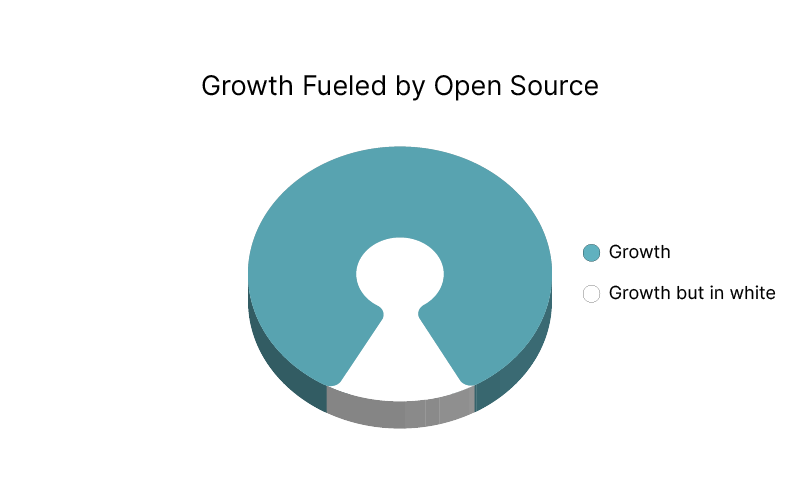Table of Contents
With the modern business landscape becoming more and more saturated and competitive in recent years, companies worldwide face an ongoing challenge of emerging through the noise and initiating growth. The resources are often suboptimal, which can make the process of developing a cost-effective and sustainable business strategy an insurmountable problem for many companies.
Luckily, with the emergence of technological solutions like managed cloud services and open-source platforms, the process of creating budget-friendly infrastructures and finding optimal business strategies becomes much less insurmountable.
Open-source software, cloud computing, and software-as-a-service (SaaS) comprise a triumvirate of technology megatrends that are currently the best drivers of business growth. Cloud computing services alone are shaping up to be among the biggest markets out there, with predictions that it could reach $832.1 billion by 2025, while the forecast for the open-source services market reads $66.3 billion for the same time frame.
According to a recent survey conducted by Aiven, 91% of developers say open source is in their future, while 85% of enterprise-level companies are already using open source. The increase in the adoption of open source platforms, coupled with the boom of managed cloud services, is an undeniable indicator of business growth being fueled by the plethora of opportunities these technologies provide.
Open Source as the Source of Growth
It is hard to imagine an industry and/or technology that isn’t powered by an open-source today. Just as it is almost impossible to find a successful, future-proof business that isn’t utilizing managed cloud services. The concepts of permissive software license and open source enable companies to create more agile environments, allowing them to achieve much more streamlined workflows without making a huge dent in their resources. When your business is capable of moving forward at a much higher pace, having enough room for experimenting and innovation while staying ahead of your direct competitors is a much easier task.

Open-source technologies allow for this environment as they feature high transparency levels and are open to inspection. They empower you to utilize and process your own data without being tethered to the capabilities of a single vendor or a single product. This is a prerequisite for any business that looks for new ways to improve their TTM (time to market), increase revenue, and stay future-proof.
Why Open Source Cloud?
The benefits of using the basic open-source concept are numerous:
Transparency – the end-user gets full visibility into the code base and gets insight into all discussions about how the open-source community creates features and solves bugs.
Community-Powered Innovation – global communities that unite around improving open source solutions reach new capabilities and introduce new concepts faster and more effectively than internal teams working on proprietary solutions.
Reliability – with more brainpower tackling the open-source code development, the levels of overall reliability tend to be higher.
Cost-effectiveness – open source solutions don’t require licensing fees which is a huge advantage when looking at the total cost of deploying a solution.
Maximize Your Cloud Investment
Unlock the secrets to better cloud infrastructure management. Let’s maximize the value of your investment
Learn more about managed cloudImproved Security – powered, thoroughly reviewed and vetted by the community, the open-source software’s code is often more secure.
Improved TTM (time to market) – since these solutions are available to be explored for free, it’s often much faster to investigate options and get solutions off the ground.
The list goes on.
The size of the team working on an open-source project allows for a faster, highly efficient and more reliable workflow as it enables team members to identify, diagnose, and resolve bugs more quickly. Leveraging these advantages of open source software makes this model more secure and an overall better solution when compared to proprietary software.
However, it does come with a few caveats and challenges.
Challenges of Open Source
For instance, the implementation of open source solutions can often be a more complex task than implementing proprietary software. If the solution is not plug-and-play in the same way as proprietary software is, the implementation process can seem too convoluted, especially if it doesn’t fit your business use-case right from the get-go. These scenarios may require the use of patches coupled with various updates in order to keep the open-source solution functional.
These challenges are somewhat of a package deal with open source as the main idea behind this model is that is built for the community. Although the global open source community is responsible for numerous innovations and technological improvements, open-source software projects do not actually come with the direct support for individual businesses who seek to use these solutions.
The remedy for this?
Managed Cloud Open Source
Managed open-source resolves most of the key challenges that come with using open source software by enabling businesses to reap the most critical benefits of open source solutions while removing the responsibilities of management and maintenance from the equation.
Most typically, managed open-source providers tackle the implementation, maintenance, and security processes, which grants in-house developers enough room to focus their time and expertise on more revenue-driving work. This configuration helps companies move forward more quickly, with more opportunities to drive business growth as their main overarching goal.
Managed Open Source and Managed Cloud: a Heavenly Match

According to Gartner, the global IaaS public cloud services market grew 40.7% in 2020, while Forrester predicts the global public cloud infrastructure market will inflate by an additional 35% by the end of 2021, reaching $120 billion in sales. What is most exciting for this article’s topic is that the key driver for the increases in both open source adoption and cloud enablement is the very same concept – improved business agility and increased ability to innovate at faster rates.
This is why businesses that manage to combine managed cloud services with effective use of open source (and scale them according to their unique business needs), turn out to be among the most successful within their industry. When your company finds just the right mix of open source software and managed cloud technology, and implements these solutions with adequate support, the business growth rate can only go up.
Managed Open Source Cloud as the Business Model of Future Growth
It is no surprise that more and more organizations are moving the majority of their computing architecture off-premise and into the cloud. With the evident rise in security levels and utilitarian value for the end-user, companies have become far more comfortable with hosting their infrastructure and processes in the public cloud. The main culprits for this trend are Amazon Web Services, Google Cloud, and Microsoft Azure managed cloud platforms that have made the decision to abandon legacy on-premise architecture models and migrate to the cloud much easier.
Managed cloud and open source go hand in hand, which is best visible in the fact that most open source companies – like Elastic, GitLab, Confluent, DataBricks, MongoDB, HashiCorp, JFrog, etc – offer at least some portion of their products and services through cloud services.
This ongoing trend is a solid indicator that this model is evidently on the rise.
How Managed Open Source Cloud Works
The typical model involves open-source companies hosting and managing their entire stacks in the cloud while charging subscription/consumption fees to end-users so they can use their services and access various functionality tiers. The open-source company would usually offer the most basic service tiers that include the free open core only, with upsell options for paid tiers with progressively higher functionality levels and additional features.
These cloud system models promote and boast cost-effectiveness as well as ease of use. They allow users to spin up and manage their own environment in order to run a service, while they also mitigate the need for experienced employees who can run and maintain such architectures. This low-friction and easy upsell model offers advantages that helped many open source companies (like Elastic and JFrog) to grow fast.
On the other hand, the cloud services model does have a small set of challenges.
For instance, an open-source company can decide to contribute its code to a foundation that supports open-source projects (like The Apache Foundation), which can help that company reach wider distribution. The open-source company can benefit greatly from the community and the trust accreted around the foundation. However, this deal can cause them to lose a certain amount of control over the way users go from open source usage to commercial feature consumption.
Another emerging challenge is the rising competition in the form of open-source companies that come from the public cloud providers themselves. AWS, Google Cloud, and Microsoft Azure are now providing hosted versions of popular open-source software, and are offering them at surprisingly low rates. These cloud giants also offer additional added-value proprietary services on top of the open core, which means that competition among commercial open source companies is going to skyrocket in the years to come. The rate of future business growth is bound to do the same.
To Sum Up
As the innovation within the cloud-based technological landscape progresses, the level of usability needs to follow suit. If the usability of certain cloud technology is low and its business model suboptimal for the end-user, the adoption is going to be slow and is likely to wane instead of increase. A great example of this notion is open source technology. Even if you have a highly functional and complex open-source technology that is cloud-native (like Kubernetes, Spark, or Kafka, for example), their adoption and use won’t be as widely spread as one might assume because these platforms are difficult to utilize, manage, and monitor.
This is exactly where the managed cloud comes into play.
When combined, managed cloud and open source solve these challenges by helping businesses enjoy all the richness of features that comes with the open-source product, while paying for the services that make this product user-friendly.
